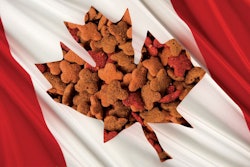
Nearly half of US pet retailers anticipate their stores’ sales of premium and custom pet foods to increase in 2018, according to a survey just released by Pet Product News magazine. The 48 percent of respondents saying so compares favorably to the 8 percent who said they expect sales of premium or custom pet foods to decline.
The survey was conducted in late summer 2017 among US independent, chain and franchise pet retailers, the magazine said, though unfortunately, no data is provided in terms of number of respondents or the response rate. Yet several interesting data points are available, such as 70 percent of respondents saying they expect some level of increase in sales in 2018, ranging from 1 to 10 percent up to more than 20 percent. Further, the percentage of retailers reporting more than US$1 million in annual sales rose to 19 percent, up from 14 percent in 2014 (presumably the last year for which the survey was conducted). At the other end of the spectrum, 20 percent of respondents reported annual sales of less than US$50,000.
Dog and cat food and treats reign
That so many US pet retailers project a sales increase for premium pet food is especially positive in that, no surprise, dog and cat food and treats rank as major product categories for their stores. First, all products for dogs and cats accounted for 47 percent, on average, of respondents’ annual sales – far outranking the next largest category, grooming and related products, at 18 percent, or the next largest species-related category, products for fish, at 8 percent.
Breaking down product categories by species, 54 percent of respondents identified dog food as a key category, with 53 percent naming dog treats. For cats, the percentages were 49 and 30, respectively. And despite the positive outlook for premium pet food sales, a respondent’s quote included in the survey alludes to the fact that product characteristics traditionally tied to premimization are now starting to pervade lower-priced products, too: “The trends I see are for less-expensive and non-GMO food,” said Lisa Gay, co-owner of H3 Pet Supply in Stratford, Connecticut, USA. Everyone wants the same “clean” food for their pets that they themselves consume, she added.
Effects of pet food e-commerce and online competition
As the internet continues to grow as a popular and influential retail channel among consumers, this year’s pet food market news has been rife with stories about pet food companies pulling their products from ecommerce sites like Chewy.com, Amazon continuing to gain sales and market share from pet food sales and the like. Seeing how US pet retailers are responding to e-commerce is insightful.
For example, 51 percent of respondents to this survey consider competition from online vendors as the most significant threat to the pet product retailing business. Diving deeper, 32 percent said they view online competition as a significant threat, with 19 percent saying they see the threat as “considerable” and 16 percent consider it “somewhat” of a threat.
While 22 percent don’t see ecommerce as a threat at all, it’s still somewhat surprising that 78 percent do not have an online retail component to their business; and among those that do, the largest amount of sales (reported by 28 percent) is less than US$500 a year.
Yet 21 percent of respondents reported sales of US$10,000 or more, and 26 percent said they are anticipating increased online sales in 2018. Perhaps this segment of US pet retailers sees adding an e-commerce component as inevitable and necessary to stay in business as online threats increase. Pet Product News also reported that Amazon recently launched a pet profiles feature targeting the pet owners among its customer base and particularly among its Amazon Prime members, who can receive a one-time 20 percent discount on their next pet food purchase after creating a pet profile.
Pet retailers still have reasons to look forward to 2018
Other threats to traditional brick and mortar pet retailers are appearing, such as companies offering customized pet food formulas and home delivery. Yet despite all the challenges they may face, this survey’s respondents still reported multiple reasons for optimism for their businesses and the channel overall: 69 percent said they see customers spending more on their pets, 61 percent believe customers prefer small businesses versus big-box stores, and 45 percent reported their customers are demanding high-end pet food, which typically means higher prices.
As pet food goes, so goes the US pet specialty retail channel.


















